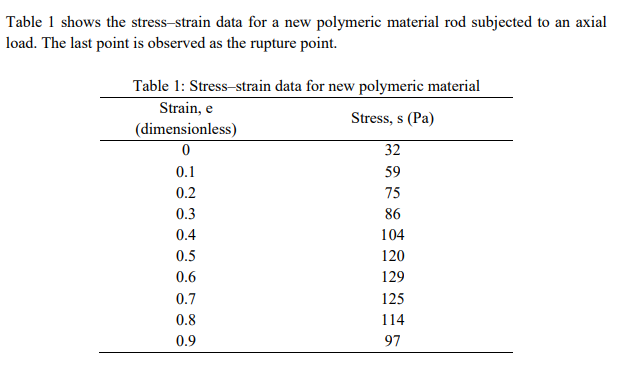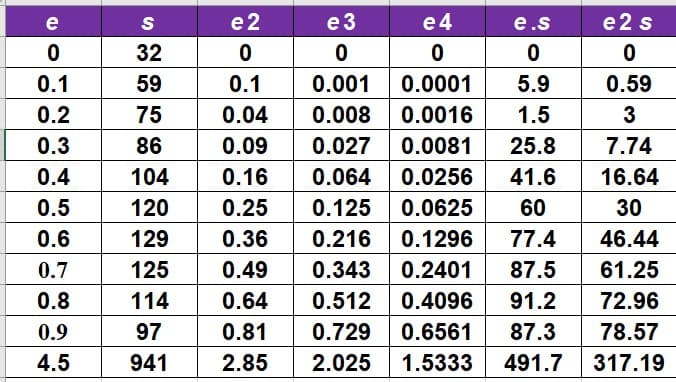Based in the table 1. (need to answer question 4,5,6) 1) Develop a best-fit equation for the relationship between stress and strain. Employ Naïve–Gauss elimination method whenever necessary. S=___28.65___+___294.43___e + ___235.22____e2 2) Determine the coefficient of determination for the equation. R2 =___0.636____ 3) Calculate the stress value to the most accurate value at strain value 0.53. s = ___250.76____Pa 4) The yield point is the point on a stress–strain curve that indicates the limit of elastic behaviour and the beginning of plastic behavior. In this case, the yield point occurs at a stress value of 80. Determine the corresponding strain value at the yield point. In any relevant method, use a stopping criterion of 0.05% e =_______ 5) The ultimate strength is the maximum point on the stress–strain curve. This corresponds to the maximum stress that can be sustained by a structure in tension. Compute the ultimate strength point of the polymeric material (strain value that gives maximum stress). In any relevant method, use a stopping criterion of 0.05%. e =______ and smax =______Pa 6) Determine the absolute error between the highest experimental data and the calculated maximum concentration. Error =_____%
Based in the table 1. (need to answer question 4,5,6)
1) Develop a best-fit equation for the relationship between stress and strain. Employ Naïve–Gauss elimination method whenever necessary.
S=___28.65___+___294.43___e + ___235.22____e2
2) Determine the coefficient of determination for the equation.
R2 =___0.636____
3) Calculate the stress value to the most accurate value at strain value 0.53.
s = ___250.76____Pa
4) The yield point is the point on a stress–strain curve that indicates the limit of elastic behaviour and the beginning of plastic behavior. In this case, the yield point occurs at a stress value of 80. Determine the corresponding strain value at the yield point. In any relevant method, use a stopping criterion of 0.05%
e =_______
5) The ultimate strength is the maximum point on the stress–strain curve. This corresponds to the maximum stress that can be sustained by a structure in tension. Compute the ultimate strength point of the polymeric material (strain value that gives maximum stress). In any relevant method, use a stopping criterion of 0.05%.
e =______ and smax =______Pa
6) Determine the absolute error between the highest experimental data and the calculated maximum concentration.
Error =_____%


Step by step
Solved in 3 steps









